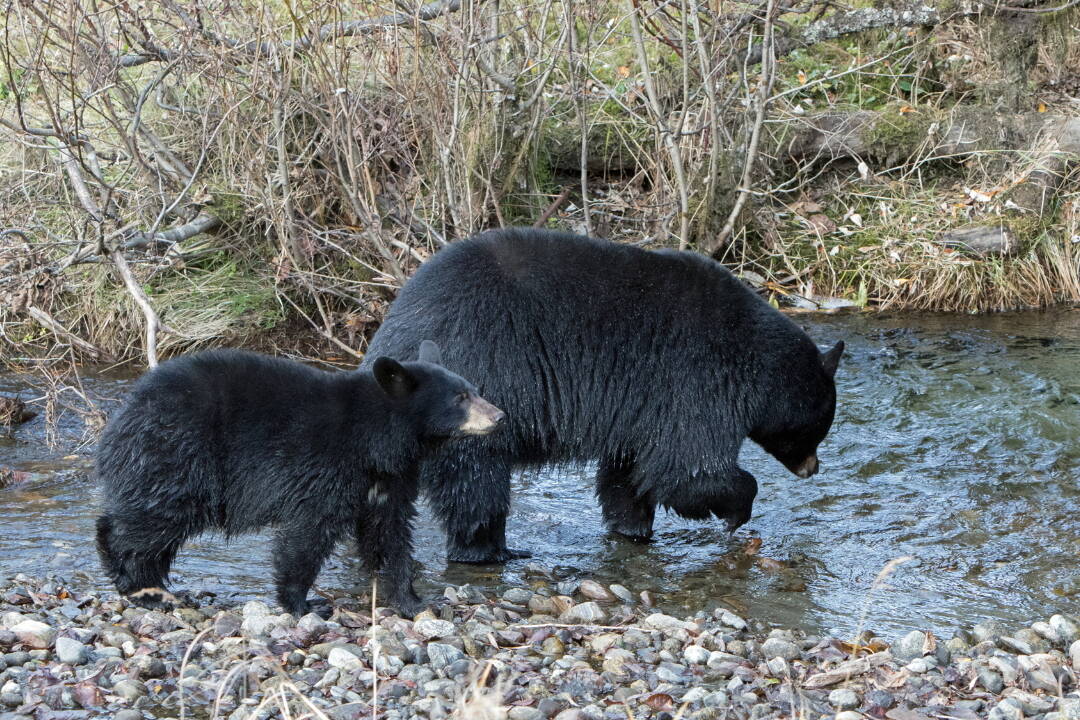There are two basic life-cycle patterns among animals. Many animals have complex life cycles with two or more very distinct stages; metamorphosis is the usual term for the often-radical changes that occur between stages. Think, for instance, of caterpillars turning into butterflies or tadpoles becoming frogs. Contrast that with what’s called direct development: a puppy is clearly a dog for all its life, and a chick is obviously a bird, growing and changing gradually, without distinct stages. Like dogs and chickens, bears and humans have a direct-development life cycle.
For starters, consider some of the overwhelming variety of critters that have complex life cycles — enough variations to fill a huge catalog (and all with special names sufficient for a big dictionary—but I’ll leave those out). Here are some examples:
• Amphibian larvae (tadpoles) typically lose their tails and grow legs as they change to adult form.
• Fish larvae usually look like “typical” fish with some modifications, typically living off food stored in their yolk sac. They then change to juvenile forms, in some cases looking much like miniature adults, although their physiology may differ (e.g., salmon). But in some cases the juveniles look quite different. For example, in certain wrasses, the small juvenile has numerous frills on the fins that disguise its underlying fishy shape, and then all those frills are lost when becoming adult. And flatfish larvae change from a symmetrical fishy shape to an asymmetrical arrangement with both eyes on one side.
• Caterpillars (lepidopteran larvae) transition to an immobile pupa, in which the body is totally reorganized (digestive tract, brain, all of it) to form a winged adult.
• Dragonflies do a less total transformation, developing adult wings and legs inside the larval skin.
• Jellyfish have a little oval, short-lived planktonic stage that swims using minute hairs (cilia) on its surface. It then settles on a surface and develops into a polyp, which buds off the adult-form medusa.
• Most molluscs have one or two planktonic stages that feed and swim, using cilia or ciliated flaps. The final larval stage typically disperses and settles; then it develops into an adult, often with a shell (such as a clam). Some, however, have an additional, parasitic stage (attaching to fish), before they settle and mature.
• Crustaceans often pass through several free-living juvenile stages, molting between stages and having varied morphology, until the last one morphs into a small adult form (such as a crab or a barnacle) that just grows larger. For example, barnacles have a planktonic form that feeds and swims, using long bristle-like hairs. It then transforms, after several molts, into a different, non-feeding, multi-legged, swimming form that eventually settles onto a hard surface, gluing its head down and leaving the legs free for capturing food, as it creates a hard shell around the now-sedentary, adult body.
• Sea urchins have a planktonic stage with bilateral symmetry; this form settles onto a surface and develops five-sided radial symmetry in the familiar prickly juvenile-to-adult phase.
Complex life cycles dominate among insects (estimated to be more than 80% of the species) and other invertebrates. Clearly, that plan for living is highly successful. Some researchers suggest that the ‘invention’ of complex life cycles may even have led to the evolution of the huge diversity of insects. All this begs the question: what are the advantages of such life cycles?
Although physiologists have unraveled some of the intricate physiological orchestrations that govern the process of metamorphosis, the possible ecological advantages of having distinct life-history phases are less amenable to experimentation. They can be explored with ecological, mathematical models, but remain more a matter of conjecture. We certainly observe morphological, behavioral, and ecological differences between life-cycle stages, but are those differences the ones that led to the evolution of the distinct stages (and if so, how)?
Clearly, the different stages can play different roles; they may specialize in feeding, or dispersal, or settling, or (in what we call adults) reproduction. A feeding stage like a caterpillar may be efficient at feeding but have limited mobility, making it hard to find mates. So a mobile dispersal phase — such as a butterfly — could be more effective in reproduction.
In addition, perhaps one stage might have found a way to exploit some different, rich food source that allows faster growth, maybe achieving reproductive status more quickly. Also, if immature and mature stages have different diets or habitats, there is less competition between them, possibly enhancing survival. Different stages could be exposed to different predators or diseases. If the threats are stage-dependent, such species might escape the possibility of species-wide devastation, by differing in behavior or habitat. However, we are left with lots of conjecture and little concrete documentation.
Complex life cycles are very common, but what about the animals that have direct development? That, too, is a successful way of life for some species — we see it in the abundance and diversity of reptiles, birds, and mammals. Furthermore, within some taxonomic groups, certain lineages have lost one metamorphic stage although their close relatives retain them. For instance, although most amphibians have complex life cycles, some salamanders have given up the adult form and reproduce in their larval form. Females (but not males) of a few species of flies and beetles have no typical adult stage, but reproduce in larval form. Among the molluscs, pulmonate snails generally have direct development: an egg produces not a larva, but a mini-snail. In these critters, one body form accomplishes all the activities performed by multiple stages in complex life cycles. All of these animals are apparently successful too.
But what were the ecological and historical situations that led to the evolution of such different life histories? There is a lot to wonder about!
• Mary F. Willson is a retired professor of ecology. “On The Trails” appears every Wednesday in the Juneau Empire.

